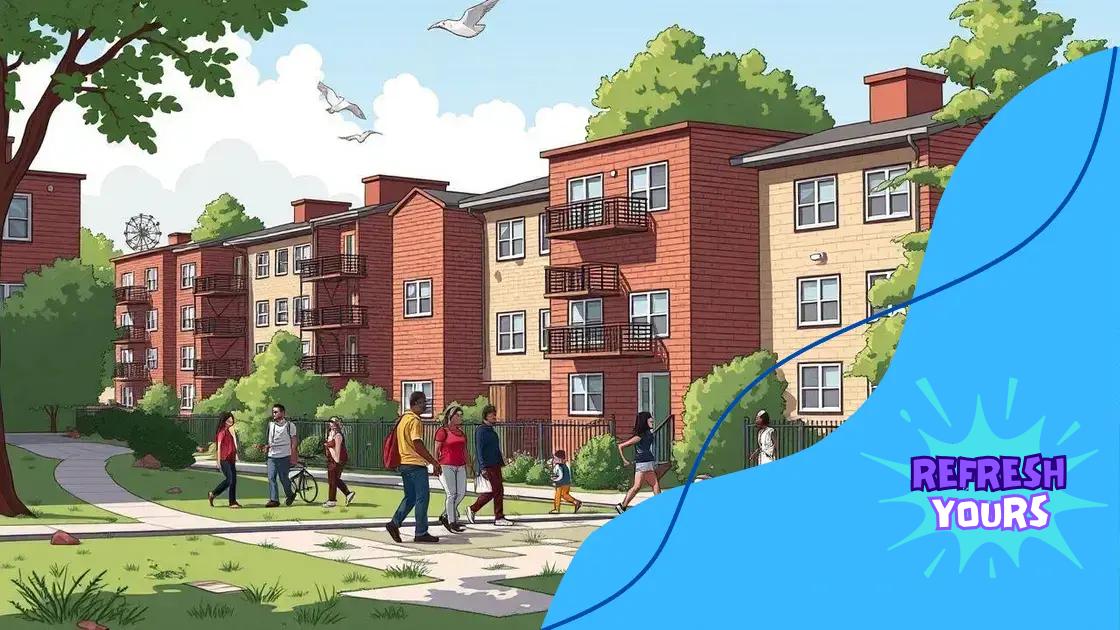Federal funding for affordable housing in urban areas

Federal funding for affordable housing in urban areas includes various programs like LIHTC and HOME, which support the development of diverse, affordable living spaces through public-private partnerships and innovative financing solutions.
Federal funding for affordable housing in urban areas plays a vital role in shaping accessible communities. Have you ever wondered how these funds transform city living? This article delves into the programs that make affordable housing a reality for many.
Understanding federal housing funding programs
Understanding federal housing funding programs is essential for grasping how affordable housing is developed. These programs are designed to provide financial support to various entities like municipalities, non-profits, and developers aiming to create low-cost housing options.
Types of Federal Housing Funding Programs
There are several programs available that cater to different needs. These can include:
- The Low-Income Housing Tax Credit (LIHTC)
- The HOME Investment Partnerships Program
- The Community Development Block Grant (CDBG)
- The National Housing Trust Fund (NHTF)
Each of these programs has unique features and eligibility requirements designed to address specific challenges in housing. For instance, the LIHTC helps investors receive tax credits in exchange for funding affordable housing projects, making it a crucial component of the housing finance landscape.
Furthermore, the HOME program allows communities to create affordable housing tailored to local needs. It provides grants to states and localities, focusing on families in need. These funds can be used to develop, rent, or purchase affordable housing units.
How Funding Impacts Communities
The effectiveness of federal funding is evident in urban areas where these programs have been successfully implemented. By providing financial resources, these initiatives help to revitalize neighborhoods and improve living standards.
Benefits often seen include:
- Increased availability of affordable housing
- Improved community facilities and services
- Support for local economies through job creation
In addition to increasing housing availability, these programs can also foster mixed-income communities, enhancing diversity and reducing segregation. By understanding the variety of funding programs, stakeholders can effectively lobby for resources and create solutions to housing shortages in urban areas.
Impact of funding on urban communities
The impact of funding on urban communities is profound and multifaceted. When federal funds are allocated for affordable housing, they do more than just create homes. They transform entire neighborhoods and enhance the quality of life for residents.
Economic Growth
One significant area of impact is economic growth. Affordable housing initiatives not only provide shelter for low-income families but can also stimulate local economies. New housing developments often lead to:
- Job creation during construction
- Increased demand for local businesses
- Higher property values in revitalized areas
As a result, these projects can foster a cycle of growth that benefits everyone in the community.
Moreover, by reducing housing costs, families have more discretionary income to spend on necessities and local services. This economic boost can create a healthier community environment as residents invest in their own neighborhoods.
Social Cohesion
In addition to economic impacts, funding for affordable housing encourages social cohesion. When diverse populations live in the same area, they share experiences and resources, which strengthens community ties. Housing funds play a critical role in:
- Creating mixed-income neighborhoods
- Encouraging community programs and social activities
- Reducing crime rates through increased community engagement
This social interaction leads to stronger networks and a sense of belonging, making the community resilient against challenges.
Furthermore, access to quality housing often correlates with better educational opportunities. Children from stable homes tend to perform better in school, leading to long-term benefits for the entire community.
Challenges and Opportunities
However, the impact of funding is not always positive. Challenges can arise, such as gentrification, where increased housing development drives up costs and displaces long-time residents. It’s vital for policymakers to balance the benefits of funding with the potential downsides. Local governments and organizations must work together to ensure that housing development meets community needs without causing harm.
In summary, the impact of federal funding on urban communities reveals a complex landscape of economic and social factors. By ensuring that funding is used thoughtfully and inclusively, communities can thrive and offer their residents expanded opportunities.
Challenges in accessing federal housing funds

Accessing federal housing funds presents several challenges for developers, non-profits, and local governments. These obstacles can hinder the effectiveness of programs aimed at creating affordable housing.
Complex Application Processes
One of the primary challenges is the complexity of the application process. Many funding programs require extensive documentation and detailed proposals. This can be daunting for smaller organizations that may lack the resources to navigate the bureaucracy. For instance, gathering the required financial data and project plans often takes significant time and effort.
- Lengthy wait times for approvals
- Strict eligibility criteria
- Frequent changes in funding guidelines
This intricate process can deter potential applicants and slow down the development of affordable housing projects.
Lack of Awareness and Education
Another issue is the lack of awareness about available funding sources. Many communities do not know what federal programs exist or how to access them. Education and outreach are crucial to bridge this gap. Effective communication can enable more stakeholders to engage in the funding process.
Residents and community leaders should be informed about:
- How to apply for funds
- Eligibility requirements
- Potential timelines for funding
Without this knowledge, many opportunities for financial assistance go untapped, limiting the development of affordable housing.
Community Resistance
Additionally, there can be community resistance to new projects that come from federal funding. Sometimes, residents worry about how new developments will impact their neighborhoods. This can lead to opposition against projects, even if they are aimed at providing affordable housing. Local governments must actively engage with the community, addressing concerns and emphasizing the benefits of these developments.
Fulfilling the goals of affordable housing initiatives requires collaboration among agencies, developers, and local communities. Strategies to overcome these challenges must be prioritized to ensure successful funding outcomes.
Case studies of successful funding projects
Case studies of successful funding projects can provide valuable insights into how federal financing has made a significant impact on affordable housing. These examples illustrate effective strategies and highlight the positive outcomes that can result from well-executed funding initiatives.
Example 1: The Affordable Housing Development in Chicago
In Chicago, a project aimed at revitalizing a struggling neighborhood received federal funds through the Low-Income Housing Tax Credit (LIHTC). This funding allowed the development of over 100 affordable housing units. The project included:
- Energy-efficient designs
- Community spaces for residents
- Accessibility features for seniors and disabled persons
As a result, this development not only provided homes but also fostered a sense of community and pride among residents.
Example 2: Mixed-Income Housing in Portland
Another successful case is the mixed-income housing project in Portland, funded by the HOME Investment Partnerships Program. This project brought together low-income and market-rate housing, promoting diversity and inclusion. Notable achievements include:
- Reduction in homelessness rates in the area
- Employment opportunities created during construction
- Enhanced neighborhood amenities, like parks and community centers
This project showed how mixed-income strategies can enhance urban communities while accommodating residents from various backgrounds.
Example 3: The Community Development Block Grant in Miami
In Miami, federal funds from the Community Development Block Grant (CDBG) enabled a historic building to be transformed into affordable housing for low-income families. This initiative preserved the character of the neighborhood and provided essential services nearby. Key outcomes of this project included:
- Improved housing quality and safety
- Access to supportive services for families
- Increased local engagement in promoting community events
The blending of historic preservation with modern housing needs has enriched the area while respecting its cultural significance.
These case studies exemplify how federal funding programs have the potential to create lasting change in urban communities. They highlight that with the right planning and implementation, funding can effectively address housing shortages and enhance the overall well-being of residents.
Future trends in affordable housing funding
The future trends in affordable housing funding are shaping the way communities develop and sustain affordable living options. As cities grow and demographics shift, innovative funding solutions are becoming essential.
Increased Public-Private Partnerships
One notable trend is the rise of public-private partnerships (PPPs). These collaborations leverage resources from both government entities and private developers. By pooling funds and expertise, PPPs can:
- Accelerate the development of affordable housing
- Reduce financial risks for developers
- Encourage sustainable and innovative building practices
This approach not only enhances efficiency but also leads to more inclusive community projects.
Expanded Use of Technology
Technology is also transforming how affordable housing is funded. Online platforms are emerging to connect investors with funding opportunities in the housing sector. Crowdfunding models allow everyday citizens to invest in projects. This trend can:
- Lower the barriers to entry for small investors
- Foster community involvement in housing development
- Increase the accessibility of funds for diverse projects
By harnessing technology, developers can tap into new reservoirs of financial support.
Focus on Sustainability
An increasing focus on sustainability is influencing funding decisions. Funders are now more likely to support projects that prioritize energy efficiency and environmental responsibility. This includes:
- Incorporating green building materials
- Implementing renewable energy solutions
- Designing spaces that promote well-being and community interaction
Such projects not only meet housing needs but also contribute positively to the environment.
Inclusionary Zoning Policies
Furthermore, inclusionary zoning policies are becoming more prevalent. These policies require that a percentage of new development be allocated for affordable housing. This trend encourages:
- Greater integration across income levels
- Stronger community bonds
- More equitable access to quality housing
These policies can create long-lasting benefits for neighborhoods by ensuring diversity and reducing segregation.
As we look ahead, the landscape of affordable housing funding is evolving. Adapting to these trends will be crucial for communities aiming to provide secure and affordable living options for all residents.
FAQ – Frequently Asked Questions about Federal Funding for Affordable Housing
What are the main sources of federal funding for affordable housing?
The main sources include the Low-Income Housing Tax Credit (LIHTC), HOME Investment Partnerships Program, and Community Development Block Grants (CDBG).
How can communities leverage public-private partnerships?
Communities can collaborate with private developers to share resources and expertise, leading to faster and more efficient affordable housing projects.
What role does technology play in affordable housing funding?
Technology facilitates crowdfunding and connects investors with affordable housing projects, making it easier for neighborhoods to access funding.
How can sustainable practices enhance affordable housing projects?
Sustainable practices improve energy efficiency and create healthier living environments, attracting more funding and support from communities and investors.





